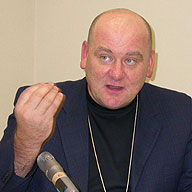An Interview with Andrey Osipov
Prophet from the Past
Q: What is the significance of creating a documentary about Andrei Bely?

AO: From the vantage point of the general public, Bely was an extremely bizarre person, perhaps someone who was being used by God, a prophet, or an alien from outer space. He was incomprehensible, and his way of living and perspective were rejected by ordinary people. But with the passage of time, people from other eras have returned to Bely have been able to comprehend him. The past ten years have been a period of tremendous economic and social upheaval for Russia, and he has become a poet that enables people to move ahead without getting lost, in the midst of temptation and other mindsets. I think it’s very important to communicate complex issues to the audience, and while I know Bely will not impact everyone, I hope this film enables viewers to be touched by his life and destiny.
Q: Can you tell us about the background leading to the production of this film?
AO: Before this film, I made a work called Voices about the Russian poet Maximilian Voloshin, and decided to make a trilogy about the poets of Russia’s Silver Age with the same production team. This is the second piece in the series. The three poets had perspectives that were at odds with ordinary people, and were perhaps entrusted with important messages from heaven.
Q: Why did you decide to tell Bely’s story using footage from silent films?
AO: The symbolist poets didn’t draw distinctions between their creative work and personal lives, and likewise the work takes a game-like approach. This work uses silent films, which were regarded as entertainment and illusions by contemporary audiences, like games for amusement. I saw a connection between the ideas of the symbolists and the amusement promised by the era’s silent films. Also, in the 1910s films were regarded as fantasies and were not yet established as art, and I was interested in exploring the transition during the 1920s as film evolved from entertainment to art through influences like German expressionism.
Q: Can you tell us about the process of uncovering the silent film footage?
AO: There are two national archives in Russia, one with photographs and documentary footage, and another with narrative films. First I worked with the scriptwriter to select milestone events in Bely’s life and turning points in his destiny, such as going to Germany, and we created an overall narrative structure. Then we went to the archives and collected film clips. Once we found footage that seemed usable, we went back and did a more thorough study of Bely’s life. We assembled a sizable collection of footage and I worked with the scriptwriter to flesh out the documentary. It was a laborious process.
Q: Did you supplement the archive footage with your own filming, such as the reoccurring image of red flames?
AO: The film is entirely comprised of archive footage. We didn’t film any of the clips. My aim was to convey something that went beyond the facts of his story. Bely often used a solar airship as subject matter for his poetry, and in 1897, during his most active period as a writer, he wrote about himself being burned by the sun and dying. The red image of the sun symbolizes Bely’s love, his own anxieties, contemporary Russia. So I was aiming to convey more than just the things relayed by the artist. I would regard this film as a success if it enables you to feel things that go beyond the story of Bely’s life, such as solitude, Russia, or the past.
(Compiled by Ann Yamamoto)
Interviewers: Ann Yamamoto, Iyobe Kiwa
Photography: Abe Shingo / Video: Oyama Daisuke / 2003-10-15
